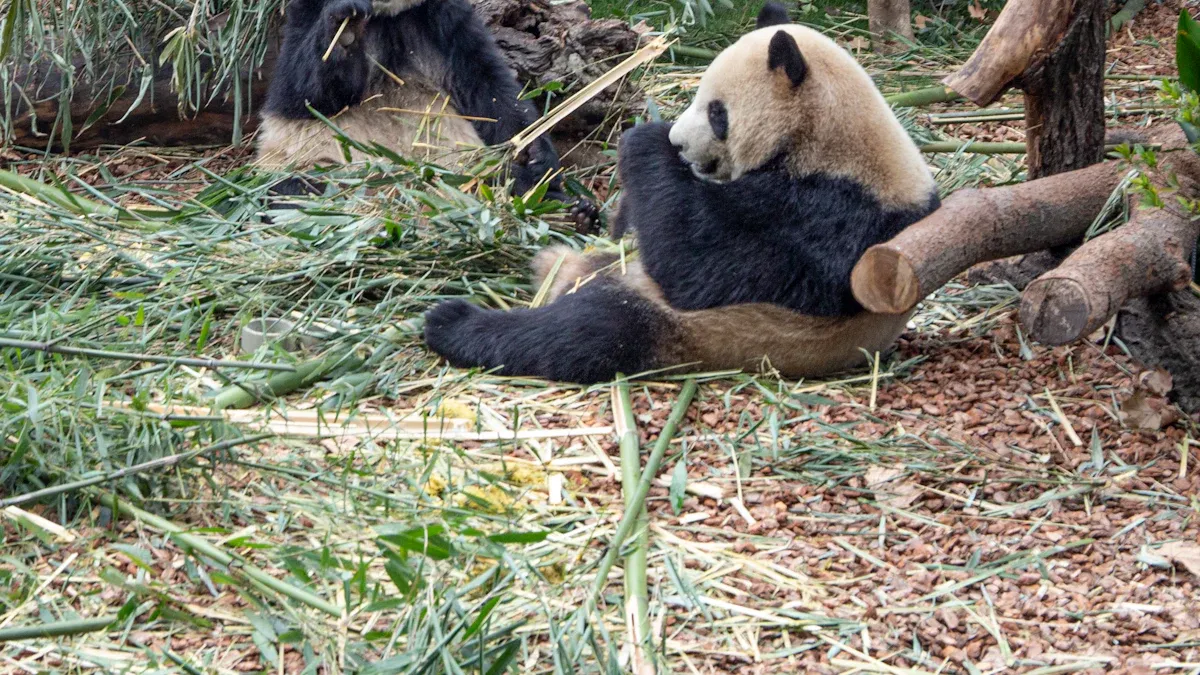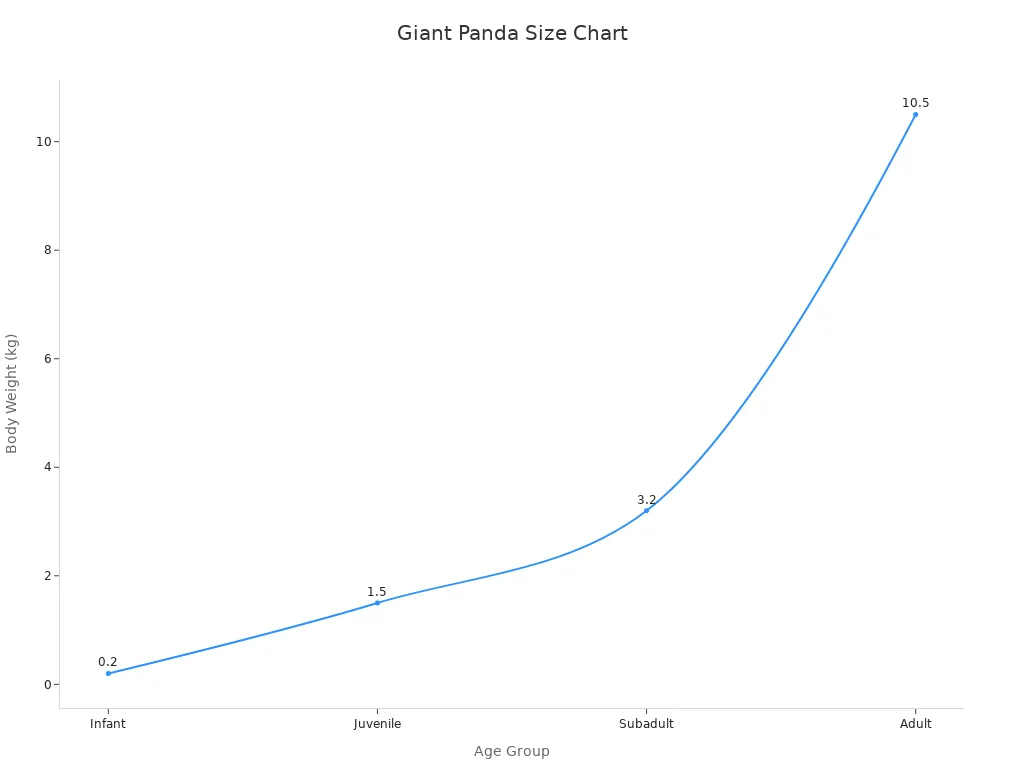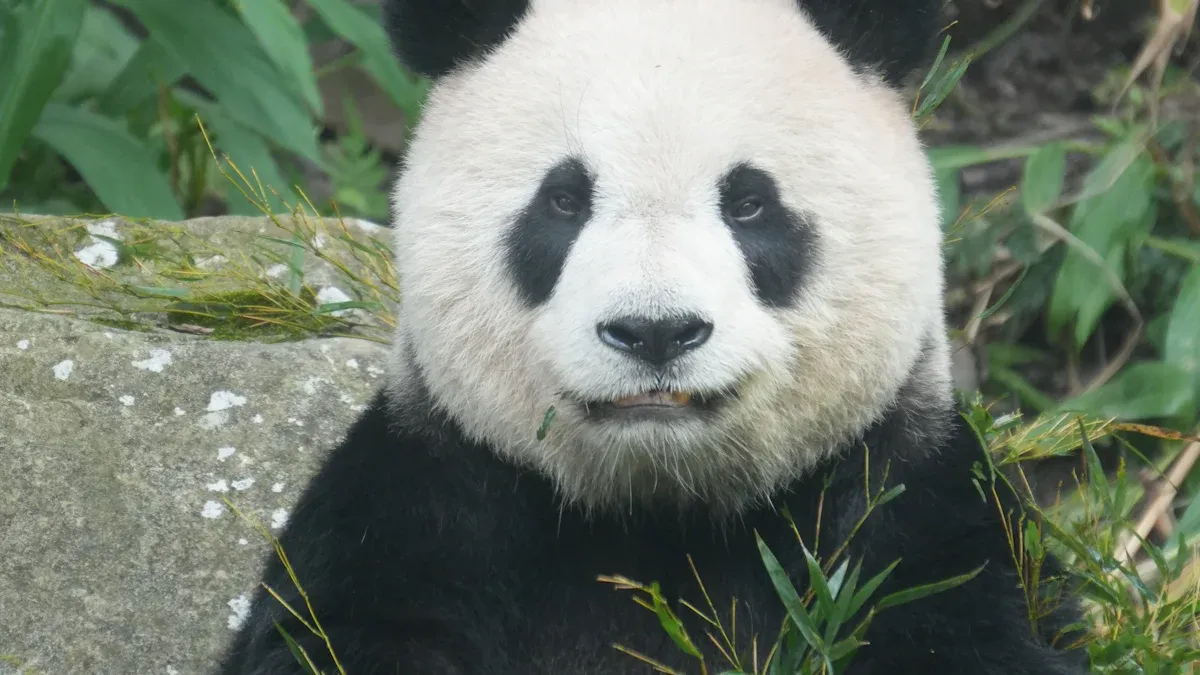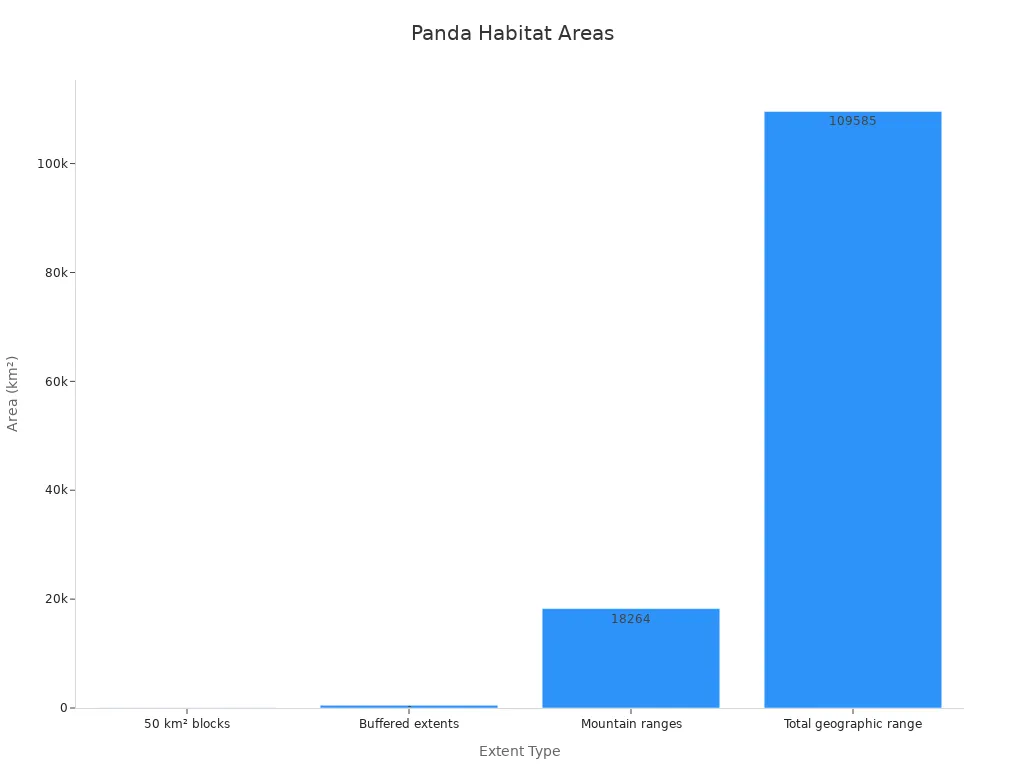The giant panda stands out with its black-and-white fur. This fur helps it hide and makes it easy to recognize. Pandas mainly eat bamboo, needing up to 40 pounds daily for energy. They have big teeth to crush bamboo and thick fur to stay warm in cold mountains.
There are only about 1,864 wild giant pandas left. Losing their homes and habitats puts them in danger. They are a symbol of nature's struggles. Conservation work has helped their numbers grow and habitats improve, but problems remain.
Physical Characteristics of the Giant Panda

Black-and-White Fur: Camouflage and Function
The giant panda's black-and-white fur is not just for looks. It helps them blend into their surroundings. The black parts match dark areas like tree trunks. The white parts blend with snow or light plants. This helps them hide from predators in their mountain homes. Their thick fur also keeps them warm in cold weather.
Fun fact: The panda's fur pattern is one of nature's best camouflages!
Size and Physical Adaptations
The giant panda's size and body features suit its bamboo diet. Adult pandas can weigh over 100 kilograms and grow up to 123 centimeters long. Their strong legs and big paws help them climb trees and move through rough areas. Below is a table showing panda growth at different ages:
|
Age |
Body weight (kg) |
Head length (cm) |
Body length (cm) |
Tail length (cm) |
Fore foot (cm) |
Hind foot (cm) |
|---|---|---|---|---|---|---|
|
Adult |
100.1 |
37.4 |
123.4 |
15.4 |
17.3 |
22.2 |
|
Subadult |
94.4 |
37.9 |
112.1 |
15.7 |
18.5 |
22.2 |
|
Juvenile |
54.6 |
35.3 |
101.4 |
13.4 |
15.9 |
19.8 |
|
Infant |
3.7 |
17.4 |
46 |
7 |
N/A |
N/A |

These numbers show how pandas are built to handle their active lives and tough environment.
Unique Features: Pseudo-Thumb and Strong Jaws
The giant panda has a special pseudo-thumb. This extra thumb, made from a wrist bone, helps them hold bamboo tightly. Their strong jaws and big skulls let them crush bamboo easily. These traits are key for survival since bamboo is 99% of their food.
The pseudo-thumb shows how pandas evolved to live in their habitat. Without it, eating bamboo would be much harder for them.
Habitat of the Giant Panda

Where Pandas Live
Giant pandas live in parts of China. They are found in Sichuan, Shaanxi, and Gansu provinces. These areas have mountains that suit their needs. Pandas like heights between 1,200 and 3,400 meters. Bamboo grows well at these elevations. The height also affects the weather pandas need to survive.

Pandas' total range covers about 109,585 square kilometers. But they live in smaller areas because of habitat loss. Below is a table showing important habitat features:
|
Variable |
Importance Level |
Notes |
|---|---|---|
|
Altitude |
p < 0.05 |
Big impact on where pandas choose to live. |
|
Tree Height |
p < 0.05 |
Important for pandas' habitat choice. |
|
Bamboo Coverage |
p < 0.05 |
Key factor for pandas' survival. |
|
Distance to Headwater |
p < 0.05 |
Affects pandas' habitat selection. |
Forests Pandas Like
Pandas live in cool forests with lots of bamboo. These forests are often misty and damp. Bamboo is their main food, so these forests are vital. The trees and plants also give pandas places to hide and rest.
Problems with Habitat Loss
Losing forests is a big problem for pandas. Farming and cutting trees have shrunk their living spaces. This makes it harder for pandas to find mates. It also reduces their genetic variety.
Wild pandas are more separated than 30 years ago. They face risks like climate change, habitat loss, and fewer chances to breed. As the climate changes, pandas will move higher into mountains. This will make them even more isolated and at risk.
Restoring forests and building wildlife paths help pandas. But there are still many challenges. Saving their habitat is key to their future.
Diet of the Giant Panda
Bamboo Dependency and Nutritional Challenges
Giant pandas eat mostly bamboo, making them very unique eaters. Bamboo is 99% of their food but has little nutrition. This makes survival harder for pandas. Bamboo is low in protein and hard to digest because of its fiber. To stay healthy, pandas eat a lot of bamboo every day.
Their gut bacteria help break down bamboo's tough parts. These bacteria ferment bamboo to make it easier to digest. But pandas' digestion works more like meat-eaters than plant-eaters. This limits how much nutrition they get from bamboo. Pandas have adapted to survive on this diet, but it’s still a challenge.
Fun fact: Panda teeth are strong enough to handle bamboo stems and leaves. Their teeth have evolved to deal with bamboo’s tiny silica particles.
Here’s a table showing important studies about pandas and bamboo:
|
Study Type |
Details |
|---|---|
|
Alpha Diversity |
Measures richness and evenness of gut bacteria. |
|
Beta Diversity |
Compares gut bacteria differences using Bray-Curtis analysis. |
|
Statistical Test |
Uses Mann–Whitney test with 95% confidence interval. |
|
Replicates |
Based on 3–4 tests with error bars showing standard deviation. |
Eating Habits and Daily Consumption
Did you know pandas eat up to 40 pounds of bamboo daily? They eat leaves, stems, and shoots for energy. Pandas spend about 14 hours a day eating. Their strong jaws and special thumb help them grab and strip bamboo easily.
Pandas eat different bamboo parts depending on the season. In spring and summer, they eat more shoots because they have more protein. But eating too many shoots can harm their health. A mix of leaves and stems keeps pandas healthy and balanced.
Here’s a table showing panda eating habits:
|
Aspect |
Details |
|---|---|
|
Study Duration |
May 25, 2014 - December 31, 2016 |
|
Bamboo Species |
Nine types of bamboo were given to pandas. |
|
Consumption Data |
Daily bamboo amounts were recorded. |
|
Food Preference |
Shows how pandas grow based on bamboo parts eaten. |
|
Analysis Method |
SPSS v25.0 was used to study food and weight patterns. |
Tip: Pandas choose bamboo parts based on seasons and what’s available. This helps them survive in their habitat.
Digestive System Adaptations
Even though pandas are carnivores, their bodies have changed to eat bamboo. They can’t break down cellulose, the main part of bamboo. Instead, their gut bacteria process other parts of bamboo like hemicelluloses.
Pandas’ gut bacteria are more like those of meat-eaters than plant-eaters. These bacteria ferment bamboo to get nutrients. The bacteria change depending on which bamboo part pandas eat. This helps pandas digest bamboo better.
Here’s a table showing studies about panda digestion:
|
Study Title |
Key Findings |
|---|---|
|
Consuming Different Structural Parts of Bamboo Induce Gut Microbiome Changes |
Gut bacteria adapt to bamboo diets and make enzymes for digestion. |
|
Unique Gut Microbiome of Giant Pandas Involved in Protein Metabolism |
Panda gut bacteria are like carnivores, showing low ability to digest fiber. |
|
Age-Associated Microbiome Shows Pandas Live on Hemicelluloses, Not Cellulose |
Pandas digest carbohydrates better than cellulose in bamboo. |
These changes show how pandas survive on bamboo, even though it’s not ideal. But their bamboo diet makes them sensitive to habitat changes.
Behavior and Lifestyle of the Giant Panda
Living Alone and Social Habits
Giant pandas mostly live alone. They don’t form groups and prefer their own space. Each panda uses scent marks from glands under its tail. These marks let other pandas know they are nearby without meeting face-to-face. But during mating season, pandas become more social. Males and females meet briefly to mate, then go back to being alone.
Sometimes pandas meet in areas where their territories overlap. These meetings are calm since pandas avoid fighting. Baby pandas, however, stay with their mothers for about 18 months. During this time, they learn how to survive before living on their own.
How Pandas Communicate
Pandas use sounds and movements to talk to each other. They make noises like bleats, growls, and honks to show feelings or intentions. For example, a bleat means they are friendly, while a growl shows anger. They also use body movements like standing up or pawing objects to communicate.
Here’s a table showing studies about panda communication:
|
Source |
Description |
|---|---|
|
Acoustic recordings provide detailed information regarding the behavior of cryptic wildlife to support conservation translocation |
Details vocalizations during breeding and post-partum periods. |
|
Explores vocal cues indicating identity and relatedness among pandas. |
|
|
Highlights how vocal behavior influences mating success. |
|
|
Focuses on the vocal repertoire of infant pandas. |
These ways of communicating are important, especially for mating and raising cubs.
Fun and Playful Actions
Pandas love to play, especially when they are young. At about two years old, pandas like Dian Dian are curious and full of energy. They enjoy climbing trees, rolling around, and playing with objects like vines. Dian Dian, for example, likes a bear ball and has a favorite tree for climbing.
Here are some fun panda behaviors:
-
Dian Dian weighs under 25 kg (55 lbs) and is very active.
-
She stands on her back legs and plays with vines.
-
Climbing trees is one of her favorite things to do.
-
She rolls and chews on toys like a bear ball.
These playful actions help pandas build strength and balance. Watching them play shows their unique personalities and charm.
Conservation Status of the Giant Panda
Threats to Survival
Giant pandas face many problems that put them at risk. Losing their homes is the biggest issue. Farming and cities have broken up bamboo forests. This leaves pandas in small, separate groups. Today, pandas live in 33 groups, some with fewer than 10 pandas. Being isolated lowers genetic variety and makes finding mates harder.
Climate change is another big danger. Experts think 37% to all bamboo habitats might vanish by 2100. Since pandas eat mostly bamboo, this would hurt their survival. Hunting, though less common now, was once a major threat to pandas.
|
Threat |
Impact Description |
Numerical Impact |
|---|---|---|
|
Habitat Loss |
Bamboo forests are shrinking, leaving pandas with less food. |
Pandas live in 33 groups, some with under 10 pandas. |
|
Hunting |
Was a big problem in the past but less now. |
N/A |
|
Climate Change |
Bamboo habitats may disappear, leaving pandas without food. |
37% to 100% bamboo loss by 2100. |
Conservation Efforts and Achievements
Efforts to save pandas have made a big difference. Wild panda numbers grew from 909 in 1980 to 1,387 in 2013. That’s a 52% increase! Protected areas for pandas also grew a lot. These reserves went from 0.57 million hectares to 2.53 million hectares, a 344% rise. These safe areas give pandas places to live and grow.
Other actions include planting trees and building wildlife paths. These paths connect forests, helping pandas find mates and improve genetic health. Laws against hunting and public education have also helped protect pandas.
-
Wild panda numbers rose by 52% between 1980 and 2013.
-
Protected areas grew by 344%, now covering 2.53 million hectares.
Importance to Biodiversity
Pandas are important for keeping their forests healthy. As they move, seeds stick to their fur and fall off in new places. This helps plants grow and forests recover. Pandas also help bamboo grow, which supports other animals.
Research in Wolong Nature Reserve shows pandas spread seeds by climbing and swimming. Protecting pandas also saves their forests, which helps many plants and animals. Saving pandas means saving nature and keeping ecosystems balanced.
-
Pandas spread seeds, helping forests grow.
-
Protecting pandas helps many species and keeps nature healthy.
The giant panda is a special animal in nature. Its bamboo diet and black-and-white fur make it stand out. Protecting pandas has shown how saving species can succeed. Helping pandas also helps the forests they live in. Protecting biodiversity means future generations can enjoy these animals. Pandas play a big role in keeping nature balanced.
FAQ
What is special about a giant panda's fur?
The black-and-white fur helps pandas hide well. Black spots match shadows, and white fur blends with snow. This keeps them safe from predators. Their thick fur also keeps them warm in cold mountains.
Why do pandas only eat bamboo?
Pandas eat bamboo because it grows a lot where they live. Their extra thumb and strong jaws help them eat it easily. Bamboo has little nutrition, so pandas eat a lot to stay energized.
How long do pandas eat every day?
Pandas eat bamboo for about 14 hours daily. They eat up to 40 pounds of bamboo for energy. Their strong teeth and jaws help them chew tough bamboo parts.
Do pandas like being around others?
Pandas mostly live alone. They use scent marks to avoid fights. During mating season, they meet briefly. Baby pandas stay with their moms for about 18 months before living alone.
How can people help save pandas?
You can help by donating to groups that protect panda homes. Learning about pandas and sharing facts also helps. Small actions can save pandas and protect nature.
